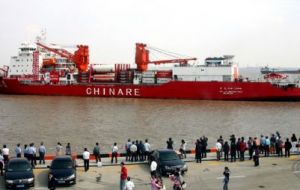MercoPress. South Atlantic News Agency
China elaborating the “most complete” map of Antarctica
 China's Xuelong (Snow Dragon) ice breaker currently docked in New Zealand
China's Xuelong (Snow Dragon) ice breaker currently docked in New Zealand Chinese scientists are expected to conclude the most complete and precise map of Antarctica during their current expedition to the frozen continent. Although much of Antarctica has been chartered and collected in maps by different countries this latest edition to be finished at the end of this year has been described “as the most complete so far”, according to a report in the Global Times.
The map will use high resolution remote sensing technology to show the distribution of key features on the continent, including sea ice, snow, blue ice, rocks, soil marshes, lakes and ice crevasses for the first time in the continent's history.
In addition, the map is based on 1,073 remote sensing images acquired from the US satellite Landsat mainly during the austral summer from 1999 to 2002, and the precision of the map is 15 meters, about 20 times better than previous maps,
“It will greatly advance our geographic knowledge of the Antarctica,” said Cheng Xiao, deputy Dean of the College of Global Change and Earth System Science, at Beijing Normal University.
The map will provide not only more accurate ground parameters for scientists to forecast global changes or global warming with climate system models, but also important data for detection of the change of Antarctica land coverage in a long run, Cheng said.
China's Xuelong (Snow Dragon) ice breaker, on the country's 26th Antarctic expedition, arrived this week to New Zealand for bunkering, fresh water replenishment and equipment maintenance.
Thirteen researchers, including a scientist from Taiwan, will board the ship during its two-day stay at Christchurch. It will be the first time for a researcher from Taiwan joins the Chinese mainland's Antarctic expedition.
An S76 helicopter rented from Australia with three crew members will also join the team in NZ. It will be used mainly for personnel and small cargo transportation during the Antarctic expedition.
Xuelong left Shanghai early October, crossed the equator October 19th and “will be leaving Christchurch on October 30 if the weather permits,” said captain Wang Jianzhong. The ship is expected to arrive at China's Changcheng (Great Wall) station, located south of King George Island, before November 15. The expedition is scheduled to return to China April 2010.




Top Comments
Disclaimer & comment rulesCommenting for this story is now closed.
If you have a Facebook account, become a fan and comment on our Facebook Page!